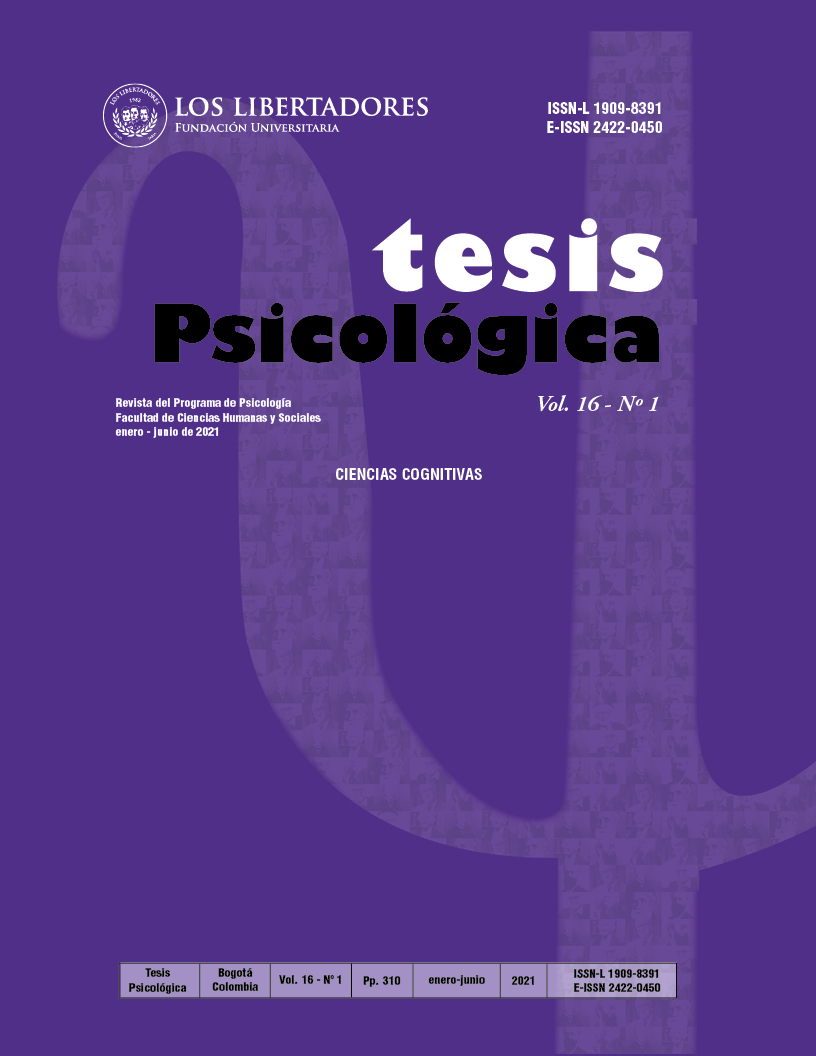Analysis of executive functions in a group of demobilized persons sentenced for aggravated homicide
DOI:
https://doi.org/10.37511/tesis.v16n1a10Abstract
Background: The study of the executive functions in people who has commit crimes such as aggravated homicide, has taken an increasing interest in neuroscience, even more in the context of armed conflict. Objective: The present quantitative investigation looks for to describe the performance of a group of demobilized from the AUC with a history of aggravated homicide, have in front of tests that measure moral judgment and executive functions of updating, shifting and inhibition. Methodology: Through a non-probability convenience sampling 17 subjects demobilized from the AUC with a history of aggravated homicide were selected, the test were made in prison or in other facilities, always under the custody of Colombian national penitentiary institute. Results: The results show that the sample does not have impaired executive function in updating or shifting, instead exhibit an impaired on inhibition susceptible to large degrees of dispersion and a general emotional difficulty to process a moral dilemma. Conclusions: it is determined that adequate moral judgment and pro social decision making are emerging characteristics of adequate executive functioning and therefore antisocial behaviors such as aggravated homicide lead to inadequate executive, empathic and moral prosecution.
Downloads
References
Aharoni, E., Sinnott-Armstrong, W., & Kiehl, K. (2014). What´s wrong? Moral understanding in psychopathic offenders. Journal of research in personality, 53(12), 175-181. https://doi.org/10.1016/j.jrp.2014.10.002
Ardila, A., & Rosselli, M., (1992). Neuropsicología clínica. Prensa Creativa, Medellín.
Blair, R., Veroude, K., & Buitelaar, J., (2018) Neuro-cognitive system dysfunction and symptom sets: A review off MRI studies in youth with conduct problems. Neuroscience & Biobehavioral Reviews, 91(8) 69-90, https://doi.org/10.1016/j.neubiorev.2016.10.022
Bueso-Izquierdo, N., hidalgo-Ruzzante, N., Daugherty, J., Burneo-Garcés, C., & Perez-García, M. (2016) Differences in executive function between batterers and other criminals, Journal of Forensic Psychology Practice, 16(11) 321-335. https://doi.org/10.1080/15228932.2016.1219216
Causadias, J., Zapata, J., Barb, G., Sanchez, E., Britton, G., (2010). Neuropsicología del crimen: función ejecutiva e inteligencia en una muestra de hombres condenados por homicidio en Panamá. Acta Colombiana de Psicología, 13 (2) 47-56. https://www.redalyc.org/articulo.oa?id=79819279005
Christensen, J.F. & Gomila, A. (2012). Moral dilemmas in cognitive neuroscience of moral decision-making: a principled review. Neuroscience Biobehavioral Reviews, 36(2). 1249-1264. https://doi.org/10.1016/j.neubiorev.2012.02.008
Colby, A., & Kohlberg, L., Speicher, B., Hewer, A., Candee, D., Gibbs, J., & Power, C. (2010). The Measurement of Moral Judgment. New York: Cambridge University Press.
Darby, R., Horn, A., Cushman, F. & Fox, M. (2018) Lesion network localization of criminal behavior. Journal of proceedings of the National Academy of Sciences of the United States of America, 3(115), 601-606. https://doi.org/10.1073/pnas.1706587115
Dobbelaar, S. (2010). Do violent offenders have more problems judging other’s emotional bodily expression than matched controls?. Bachelorthesis clinical healthpsychology, University of Tilburg http://arno.uvt.nl/show.cgi?fid=114193
Farrar, J., & Ashwell, S., (2012) Phonological awareness, executive functioning, and theory of mind. Cognitive Development, 27(1) p. 77- 89. https://doi.org/10.1016/j.cogdev.2011.08.002
Goldberg, E., (2002). El cerebro Ejecutivo: lóbulos frontales y mente civilizada. Barcelona: Editorial Crítica.
Golden, C., (2010). STROOP Test de Colores y Palabras, Publicaciones de psicología aplicada. Madrid: TEA ediciones.
Heaton, R. K., Chelune, C. J., Talley, J. L., Kay, G. G., & Curtis, G. (1997). Wisconsin Card Shorting Test. Odess, Florida: Psychological Assessment Resources (Adaptación española, 1997). Madrid: TEA Ediciones.
Hernández, R., Fernández, C., & Baptista, P., (2006). Metodología de la Investigación. México: Mc Graw Hill.
Kaufman, (2009) Test de inteligencia breve de Kaufman. Madrid: TEA Ediciones.
Kohlberg, L., Hersh, R., (2009). Moral development: a review of the theory. Journal Theory into the practice, 16. 53-59, https://doi.org/10.1080/00405847709542675
Körner. A., Volk. S., (2014) Concrete and abstract ways to deontology: Cognitive capacity moderates construal level effects on moral judgments. Journal of Experimental Social Psychology, 55 (11) 139-145. https://doi.org/10.1016/j.jesp.2014.07.002.
Congreso de la República de Colombia. (2000). Ley 599 del 2000 por la cual se expide el Código Penal. Julio 24. Diario Oficial 44.097. Art 103 – 135
Congreso de la República de Colombia. (2012). Ley 1581 de 2012 por el cual se dictan disposiciones generales para la protección de datos personales. Octubre 17. Diario Oficial 48.587
Congreso de la República de Colombia. (2006). Código Deontológico y Bioético para el ejercicio de la psicología. Ley 1090 de 2006. Septiembre 6. Colombia.
Lund, J., Toombs, E., Radford, A., Boles, K., Mushquash, C. (2020) Adverse Childhood Experiences and Executive Function Difficulties in Children: A Systematic Review. Child abuse & neglect, 106 (8) 1-12 https://doi.org/10.1016/j.chiabu.2020.104485
Marulanda, J. C., & Yáñez, J. (2018). Concepción en torno a las causas justas de la declaración de guerra. Tesis Psicológica, 13(1), 1-23. https://doi.org/10.37511/tesis.v13n1a2
McKinnon, M., Boyd, J., Frewen, P., Lanius, U., Jetly, R., Richardson, D., & Lanius, R. (2016) A review of the relation between dissociation, memory, executive functioning and social cognition in military members and civilians with neuropsychiatric conditions. Neuropsychologia, 90(11) 211-234. https://doi.org/10.1016/j.neuropsychologia.2016.07.017
Marazziti, D., Baroni, S., Landi, P., Ceressoli, D., & Dell´Osso, L., (2013). The neurobiology of moral sense: facts or hipotheses. Annals of general psychiatry, 12 (6) 1-12 https://doi.org/10.1186/1744-859X-12-6
Missier, F., Mäntylä, T., Nilson, L. (2015) Aging, Memory and decision making. Empirical and applied perspectives. Chapter 7. 127-148. https://doi.org/10.1016/B978-0-12-417148-0.00007-8
Miyake, A., & Friedman, N., (2017) Unity and diversity of executive functions: individual differences as a window on cognitive structure. Cortex, 86(1) 186-204, https://doi.org/10.1016/j.cortex.2016.04.023
Moya, L., (2011). La violencia: la otra cara de la empatía. Revista Mente y cerebro, 47, 14 – 21. https://www.researchgate.net/publication/293175974
Ostrosky, F., (2011). Mentes asesinas la violencia en tu cerebro. México: Editorial quinto sol.
Pedrero. E., Ruiz. J., Rojo. G., Llanero. M., & Puerta, C., (2012). Caracterización neuropsicológica de la impulsividad funcional y la disfuncional en adictos a sustancias: implicaciones clínicas. Adicciones, 24(1), 51- 58. https://doi.org/10.20882/adicciones.24.1
Pinedo Cantillo, I. A., Pacheco Castañeda, L., & Yáñez Canal, J. (2017). Las emociones y la moral: claves de interpretación desde una aproximación cognitiva. Tesis Psicológica, 12(1), 84-106. https://revistas.libertadores.edu.co/index.php/TesisPsicologica/article/view/759
Resches. M., Serrat. E., Rostan. C., & Esteban. M., (2010). Lenguaje y teoría de la mente: una aproximación multidimensional. Fundación infancia y aprendizaje, 33(3), 315-333. https://core.ac.uk/download/pdf/132551005.pdf
Rey, A., (2003), Test de copia y de reproducción de memoria de figuras geométricas complejas. Madrid: TEA Ediciones.
Rivera, A., (2013). Dilemas morales, juicio moral y corteza prefrontal ventromedial. Revista colombiana de Filosofía de la Ciencia, 13, 43-61. https://www.redalyc.org/pdf/414/41431644002.pdf
Rusch, T., Steixner-Kumar, S., Doshi, P., Spezio, M. (2020) Theory of mind and decition science: Towars a typology of task and computational models. Neuropsychologia, 146 (5) 1-45 https://doi.org/10.1016/j.neuropsychologia.2020.107488
Schneider, B., Koenings, M. (2017) Human lesion studies of ventromedial prefrontal cotex. Neuropsychologia, 107(9) 84-93, https://doi.org/10.1016/j.neuropsychologia.2017.09.035
Séguin, J., (2004). Neurocognitive elements of antisocial behavior: Relevance of an orbitofrontal cortex account. Brain and cognition, 55(1), 185-197. https://doi.org/10.1016/S0278-2626(03)00273-2
Stanger, N., Kavussanu, M., Willoughby, A., Ring, C. (2012). Psychophysiological responses to sport-specific affective pictures: A study of morality and emotion in athletes. Psychology of sport and exercise, 13(6), 840-848. https://doi.org/10.1016/j.psychsport.2012.06.004
Tobón, C., Aguirre-Acevedo, D., Velilla, L., Duque, J., Ramos, C., & Pineda, D. (2016) Perfil psiquiátrico, cognitivo y de reconocimiento de características emocionales de un grupo de excombatientes de los grupos armados ilegales en Colombia, Revista colombiana de psiquiatría, 45(1), 28-36, https://doi.org/10.1016/j.rcp.2015.07.004
Downloads
Published
Issue
Section
License

This work is licensed under a Licencia Creative Commons Atribución-NoComercial-













